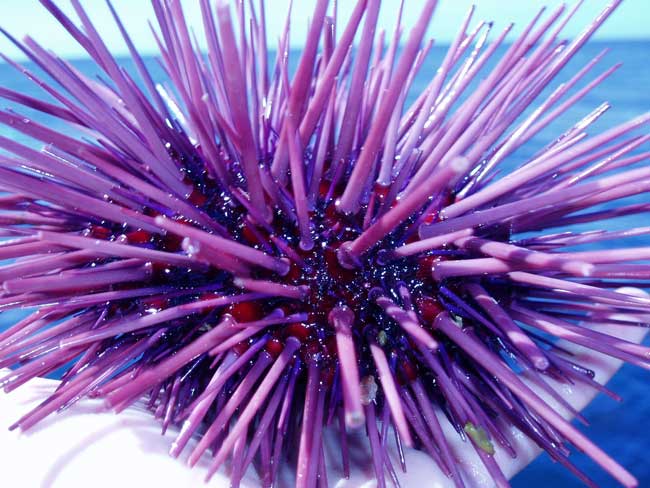Body of Sea Urchin is One Big Eye

Sea urchins may use the whole surface of their bodies as compound eyes, scientists now suggest.
Although sea urchins don't have any problems avoiding predators or finding comfortable dark corners to hide in, they don't have eyes. The question then is how they see.
Genetic analysis of sea urchins has revealed they have light-sensitive molecules, mostly in their tube feet and in tiny stalked appendages found in among their spines. As such, "it looks like the entire surface of their bodies are acting as one big eye," said researcher Sönke Johnsen, a marine biologist at Duke University.
Scientists had conjectured the spines of sea urchins might then help them pick out relatively fine visual details by screening out light from off angles. If this proved true, urchins with densely packed spines would have relatively sharp vision.
To investigate that possibility, Johnsen and his colleagues experimented with California purple sea urchins (Strongylocentrotus purpuratus), testing how 39 specimens placed in a brightly lit 4-foot-wide (1.2 m) arena responded to a black disc on the wall.
When the disc was nearly 2.5 inches wide (6 cm), the urchins seemed oblivious to the disc. However, when it was roughly 3.5 inches wide (9 cm), they reacted strongly, with roughly two-thirds racing toward it and the other third fleeing in the opposite direction. These diametrically opposed responses might reflect whether the urchins saw the disc as a shelter or predator.
"To say they 'raced' toward the discs is relative — watching these guys move is like watching paint dry," Johnsen said.
Sign up for the Live Science daily newsletter now
Get the world’s most fascinating discoveries delivered straight to your inbox.
In any case, the California purple sea urchin's vision seems roughly as good as nautiluses and horseshoe crabs, and much better than urchins Echinometra lucunter and Echinometra viridis, which have more sparsely packed spines.
"We think of animals that have a head with centralized nervous systems and all their sense organs on top as being the ones capable of sophisticated behavior, but we're finding more and more some animals can do pretty complex behaviors using a completely different style," Johnsen said.
Although sea urchins don't have brains, "it could be their entire nervous system more or less acts as a brain," Johnsen said. "In our case, we vertebrates have nervous systems that are more or less controlled by a central brain, but sea urchins have a pretty diffuse nerve net, where no region looks like a central processing unit as far as we can tell. It's hard to examine their nervous systems, since their nerves are very, very small and the animals are more or less made of rock."
The way that urchins apparently carry out eyesight and brainwork reflect how scientists are now often designing robots — more like invertebrates than we vertebrates.
"In the beginning, people built robots like they would humans, with powerful central processing units, complex sensors and fairly complex rules for doing things," Johnsen said. "Now they're finding it might be a lot better with a distributed system with many little processors and simpler sensors and simple rules, which end up creating fairly complicated behaviors as emergent properties, just as how a flock of birds can make intricate patterns without any one bird choosing these patterns."
The researchers are quite curious as to why these urchins choose to race either to or from objects. "Are there urchins that always run away or run towards them? Do we have timid or bold urchins? Or is it just something specific to how an urchin feels at a certain time?" Johnsen wondered.
Although experiments that clip spines off urchins would seem to make sense if one wanted to directly test how they contributed to vision, "we can't just remove spines — if we do, they get very sick and die, and don't behave naturally at all," Johnsen explained.
Other experiments could involve testing light objects on dark backgrounds, or if they respond to color. "It could be that they move towards green objects since they look like algae, which they really like to eat," Johnsen conjectured.
Johnsen and his colleague Divya Yerramilli will detail their findings online December 28 in the Journal of Experimental Biology.
- Surprise! Your Cousin's a Sea Urchin
- Amazing Animal Abilities
- 10 Amazing Things Things You Did'nt Know About Animals










